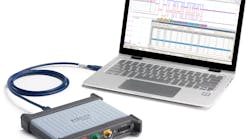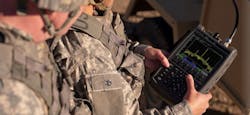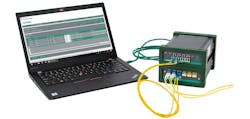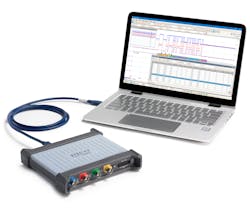Download this article in PDF format.
Bench and rackmount instruments are great for R&D and the production floor, but products ultimately leave the lab and factory, and you’ll need portable instruments to follow them. Furthermore, in the age of COVID-19, you may need an instrument that fits on your kitchen table. Vendors offer a variety of scopes and analyzers that are at home anywhere, including handheld instruments with integral battery packs with touchscreen or knob-and-button user interfaces. This includes USB devices for which a portable PC provides the user interface and power supply. In addition, some instruments designed for the benchtop are sufficiently lightweight to carry with you, but you’ll need line power at your destination.
Products
Recently introduced portable instruments from Keysight Technologies include the FieldFox B-Series handheld RF and microwave analyzers with 5G over-the-air (OTA) analysis capabilities, according to Sarah Gross, FieldFox product marketing manager.
Keysight also offers handheld oscilloscopes such as the U1620A, which combines a dual-channel oscilloscope, DMM, and data logger, according to Lynnette Reese, oscilloscope product marketing manager. A unique feature is its 200-MHz bandwidth with maximum recording length of 1 Mpts per channel, she said. Other features include a 5.7-in. sunlight-viewable VGA TFT LCD screen with enhanced color intensity and a wide viewing angle—640x480 pixels—with dual-window zoom; three viewing modes (indoor, outdoor, and night-vision); up to 10 selectable languages; and channel-to-channel isolation in accordance with CAT III 300-V safety ratings. In addition, 10 setups and waveforms can be saved and recalled internally; a field-replaceable Li-Ion rechargeable battery pack offers up to three hours of operation; and a desktop battery charger can charge spare batteries.
“With deep memory of 2 Mpts and sampling rate of 2 GS/s, non-repeating signals can be captured over a wider time base,” Reese said. “The dual-window zoom feature allows you to work more productively, by simultaneously viewing signals captured over a period of time and zooming into the most subtle details.”
Rohde & Schwarz offers several handheld instruments focused on usability and portability while bringing lab-grade features to the field, according to Richard Markley, distribution product manager. “In addition, we continue to update these models with new capabilities to address changing needs for our customers in A&D, communications, automotive, etc.,” he said. “For instance, we are adding new options to the R&S FSH handheld spectrum analyzer for EMF measurements and for capturing I/Q data. Both the R&S FSH and R&S ZPH can be equipped with waveguide calibration and measurement and EIRP measurement, to just mention a few new features.”
Battery life is another key feature. “We heard regularly from customers that they wanted devices to last an entire day in the field,” Markley said. “With instruments like our FPH Spectrum Rider, users can get up to eight hours of battery life on a single charge, and with our ZPH analyzer they can even get up to nine hours.” In addition, the batteries are field-swappable.
Anritsu offers portable instruments such as the IQ Fiber Master MT2780A multiport CPRI-based RF and PIM analyzer, which a spokesperson called the first instrument to perform true PIM analysis over fiber and present RF spectrum results derived from IQ data. The MT2780A provides field engineers, field technicians, and third-party contractors with one instrument to conduct RF interference measurements and PIM troubleshooting on LTE-based systems using CPRI front-haul infrastructure.
Pico Technology offers the 5000D Series FlexRes oscilloscopes and MSOs, which Trevor Smith, business development manager, described as laboratory-grade instruments that are compact enough to be deployed in the field or at home. “They feature up to 16 bits of vertical resolution with up to 200-MHz bandwidth and 1-GS/s sampling speed,” he said. “FlexRes hardware employs multiple high-resolution ADCs at the input channels in different time-interleaved and parallel combinations to optimize either the sampling rate to 1 GS/s at 8 bits, the resolution to 16 bits at 62.5 MS/s, or other combinations in between.” He added that the PicoScope 5000D MSO models add 16 digital channels, providing the ability to time-correlate analog and digital channels. As for battery life, Smith said a PicoScope can be powered from the host PC. “A PicoScope 5000D with two channels running draws less than 1 A, so it’s the PC power pack that needs to be selected accordingly,” he explained.
Subbaiah Pemmaiah, applications engineer at Copper Mountain Technologies, said the company has recently introduced vector network analyzers (VNAs) in its Compact family, including the S5045, M5045, SC5065, S5180, and M5180. “All our VNAs are USB-based and without a built-in computer,” Pemmaiah said. “This innovative approach separates the measurement module (VNA) from the processing module (PC), which allows the user to take advantage of the newer and faster processors available with modern computers, and yet not compromise on the measurement accuracy. With the elimination of the built-in PC, these analyzers are much smaller and lighter compared to the traditional analyzers.”
Pemmaiah said Copper Mountain’s analyzers do not have a built-in battery pack. “Since these analyzers require very low power, one can easily identify and purchase an off-the-shelf battery pack available on the market and run them continuously for a day,” he said.
Newark offers a variety of instruments, and the PicoScope 6000E Series, a fixed-resolution and FlexRes oscilloscope, was recently added to the distributor’s range, according to Jay Wimsatt, director of product operations, Test & Measurement, Newark. “The 6000E Series scopes are available in 4- or 8-channel configurations, which provide 8 to 12 bits of vertical resolution, up to 500-MHz bandwidth, and 5-GS/s sampling rate,” he said. “These units can display single-shot pulses with 200-ps time resolution.”
The PicoScope 6000E Series features deep capture memory—up to 4 GS in total, Wimsatt added. “This ultradeep memory allows the oscilloscope to capture 200-ms waveforms at its maximum sampling rate of 5 GS/s,” he said. “USB 3.0 interface and hardware acceleration ensure the display is smooth and responsive even with long captures. Eight analog channels have sufficient timing and amplitude resolution to reveal signal-integrity issues such as glitches, runts, dropouts, noise, distortion, and ringing.”
Some instruments designed for the lab can also serve as portable instruments. For example, Tektronix recently introduced updated versions of its TBS1000 and TBS2000 oscilloscopes, according to David Pereles, technical marketing manager, global marketing. “These scopes are designed for bench use, but are compact and often follow engineers and technicians into the field,” he said. “The TBS1000 weighs just 4.4 lbs. and is roughly the same size as the TDS2000, which has been used by field engineers for years.”
Pereles added, “These are line-powered oscilloscopes, so they are best suited to applications in commercial and industrial environments where line power is available. They are reliable, with robust front-ends designed for heavy use.”
Applications
Portable scopes and analyzers find use in a variety of applications. “Because FieldFox performs a variety of measurements in one portable, cost-effective formfactor, it has a place in almost any RF and microwave test environment,” said Gross at Keysight. “We primarily see it used in aerospace and defense applications (radar, satellite, etc.) and telecommunications (5G deployment, base-station testing, etc.), but it has its places in many other industries as well”— including education, component manufacturing, TV and radio, railroad, oil and gas, medical, transportation, and emergency services. “In current COVID-19 times, we see engineers working from home and using FieldFox in lieu of their normal benchtop test equipment found in their lab at work,” she added.
Gross also explained that FieldFox’s measurement precision is comparable to that of Keysight’s benchtops. “Unlike our benchtop analyzers, FieldFox was designed for portability and contains ergonomic features not found on benchtop instruments, like a carrying strap and total weight of less than eight pounds,” she said.
Reese at Keysight said the company’s portable scopes support field analysis and troubleshooting in avionics, aerospace, power-supply, and industrial-equipment installation and maintenance applications. She added that several benchtop models are also lightweight but not battery-operated. The most recent of these, introduced in March, include the EDUX1052A, EDUX1052G, DSOX1202A, and DSOX1202G, which primarily target education, small businesses, and hobbyists.
According to Markley at Rohde & Schwarz, the company offers handheld devices across many different product categories, including oscilloscopes, spectrum analyzers, vector network analyzers, and combination instruments, serving a broad industry and application set. “Industries like mobile network testing and electric vehicles are hot areas,” he said. “And when it comes to handheld oscilloscopes, the RTH is unique in that it not only has the benefits of common handheld instruments like isolated inputs and CAT IV ratings, but it also includes many features typically only found in benchtop oscilloscopes, like an MSO, serial decoding, and fast update rate.” The RTH serves as just one example of a handheld offering capabilities that are typically only found in benchtop units, he said. In addition, he added, “Our ZPH cable and antenna analyzer has a measurement speed of 0.3 ms per point—extremely fast for a handheld instrument.”
The Anritsu spokesperson elaborated on the IQ Fiber Master, explaining that it leverages patented PIM-over-CPRI and RF-over-CPRI measurement capabilities that allow tests to be conducted on the ground, reducing tower climbs. “Field engineers and technicians can use the MT2780A to scan the uplink RF signals of a remote radio head (RRH) for in-band interference while simultaneously conducting PIM over CPRI measurements,” he said. “Supporting all tier 1 LTE base-station radio manufacturers, the single instrument solution can determine if KPIs are being affected by interference or PIM.” He added that analyzing CPRI IQ data allows users to view a radio’s uplink spectrum to troubleshoot interference issues. “The IQ Fiber Master measures PIM over CPRI with four SFP inputs, providing the ability to compare multiple bands and sectors as well,” he said.
Smith at Pico Technology agreed with Gross at Keysight that many engineers are working at home because of COVID restrictions. “But they still need access to general-purpose high-performance test equipment that was previously available in their workplace laboratories,” he said, adding that PicoScope is small enough to set up on the kitchen table while offering the functionality of an oscilloscope, spectrum analyzer, logic analyzer (MSO models), protocol analyzer, function generator, and arbitrary generator, as well as a data-acquisition system for long-duration stress testing.
Smith added that while Pico T&M products are equally at home in the lab or in the field, higher-performance products such as the latest PicoScope 6000E Series 500-MHz oscilloscopes and the PicoVNA 108 8.5-GHz vector network analyzer require an external power supply. “There are some differences in how the products get used, too,” he added. “Design and test engineers mostly interact with their instrument using a mouse, while field repair technicians are more likely to choose the touch screen. But that’s just user preference—it makes no difference to the measurements or analysis that can be performed.”
According to Pemmaiah at Copper Mountain Technologies, “CMT’s Compact and 1-Port VNAs are versatile and portable. This makes them ideal for specialists working in the field, as well as laboratory and production testing in a wide variety of industries including design and production of RF components, medical devices, aerospace, etc.” He also said the company’s instruments deliver lab-grade performance while being more compact than benchtop instruments, adding that Copper Mountain’s patented reflectometer can be directly connected to an antenna or other DUT without the need of a test cable.
Wimsatt at Newark said the PicoScope 6000E Series scopes are suitable for design engineers working on high-performance embedded systems, signal processing, power electronics, mechatronics, and automotive designs as well as for researchers and scientists working on multichannel high-performance experiments in physics labs, particle accelerators, and similar facilities. “The series offers high performance with tremendous portability; it’s as flexible as any laptop,” he said. “In addition to the portability and flexibility, the PC-based design offers considerable cost savings, as it utilizes the processing power of the user’s existing computer.”
Technology innovation
Keysight integrates novel RFIC design technologies into FieldFox to enable its small-footprint multifunction capabilities, according to Gross. “These technologies also allow FieldFox to take on much higher RF power without significantly increasing power consumption,” she said. “Altogether, these innovations enable Keysight to offer a mmWave instrument for 5G testing with almost 4-hour battery life that a person can hold in one hand.”
Rohde & Schwarz designs many of its own ASICs, including those for handheld instruments, according to Markley. “Things like 10-bit ADCs are uncommon in handheld oscilloscopes, but well suited to applications like power analysis where handheld oscilloscopes are often used,” he said. “We also continue to design-in touchscreens to many of our devices,” thereby giving users a flexible environment for controlling the instrument, whether by way of a touchscreen or—should they have protective gloves on—large knobs and buttons.
Smith at Pico Technology described PicoScopes as PC-based instruments with the PicoScope 6 UI designed to take advantage of processor and display technology improvements as they become available and affordable. “So PicoScope users benefit from those innovations ‘for free,’” he said, adding that the company is working on the next-generation multiplatform PicoScope UI, with enhanced support for touchscreen operation, multiple displays, and more.
“On the acquisition side, the 5000D Series have deep waveform-capture memory, up to 512 MS—many times larger than competing scopes,” Smith said. “Deep memory enables the capture of long-duration waveforms at maximum sampling speed. Pico’s DeepMeasure tool can make use of the deep memory to analyze every cycle contained in each triggered waveform acquisition. It displays results in a table, with the parameter fields shown in columns and waveform cycles shown in rows. The current version of the tool includes twelve parameters per cycle and can display up to a million cycles.”
Smith added that PicoScope hardware can be used with PicoLog 6 application software for high-channel-count data-acquisition applications. “Up to 20 instruments, so 80 channels, can be set to record simultaneously at up to 10 measurements per second, giving virtually unlimited logging capacity to the PC, subject only to battery and hard-disk capacities,” he said.
Wimsatt at Newark elaborated on the PicoScope 6000E Series scopes. “Conventional 8-channel benchtop mixed-signal oscilloscopes can occupy too much space on the bench and are often too costly for engineers working on next-generation designs,” he said. “PicoScope 6000E Series oscilloscopes are small and portable while offering the high-performance specifications required by engineers in the lab or on the move. These oscilloscopes offer eight analog channels, plus an optional 8 or 16 digital channels with the plug-in 8-channel TA369 MSO pods. The flexible high‑resolution display options enable you to view and analyze each signal in detail.” He added that the scopes come with PicoScope 6 software, included in the cost of the scope. The software can be installed on as many PCs as the customer wants, including PCs used to view and analyze data off-line without the scope.
Ongoing advancements in measurement technology and computer technology will continue to improve the functionality and usability of portable analyzers and scopes. These instruments will serve applications including aerospace and defense as well as 5G and beyond. Their flexibility enables them to be deployed effectively in the lab, the factory, the field, and—even when COVID-19 is finally vanquished—the home.






